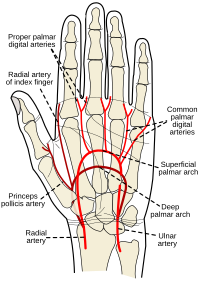
Photo from wikipedia
Address for Correspondence: Dr. Arrchana. S, Assistant Professor, Institute of Anatomy, Madras Medical College (New Building), Chennai -3, Tamil Nadu, India. E-Mail: [email protected] Background: Superficial Palmar Arch (SPA) is an… Click to show full abstract
Address for Correspondence: Dr. Arrchana. S, Assistant Professor, Institute of Anatomy, Madras Medical College (New Building), Chennai -3, Tamil Nadu, India. E-Mail: [email protected] Background: Superficial Palmar Arch (SPA) is an arterial arcade usually formed by the continuation of ulnar artery and the superficial branch of radial artery. Variations can occur in the vessels contributing to the formation of SPA. Knowledge of such variations will be very much helpful to microvascular surgeons, plastic surgeons and orthopaedicians to bring a better outcome in their surgical procedures. Also, it will be useful to the cardiovascular surgeons to carryout radial artery harvesting procedures for the purpose of Coronary Artery Bypass Grafting. The main objective is to study the different patterns of formation of the superficial palmar arch with an emphasis on their clinical importance. Materials and methods: This study was done in 40 upper limb specimens from 20 embalmed human adult cadavers at the Institute of Anatomy, Madras Medical College, Chennai. In every upper limb specimen, the palm was dissected as per the steps described in the Cunningham’s Manual of Practical Anatomy. The Superficial Palmar Arch was exposed and the vessels taking part in its formation were studied. Variations in the formation of Superficial Palmar Arch were noted and analysed. Results: Out of 40 specimens, the Superficial Palmar arch was found to be complete in 29 specimens (72.5%) and incomplete in 11 specimens (27.5%). Conclusion: Information about the different patterns in the formation of the Superficial Palmar Arch will be extremely useful for hand surgeons, microvascular surgeons, plastic surgeons and orthopaedicians to bring out a successful and beneficial postoperative outcome. Awareness about these variations will also help in appropriate interpretation of investigations prior to radial artery harvesting for the purpose of Coronary Artery Bypass Grafting.
Journal Title: International Journal of Approximate Reasoning
Year Published: 2018
Link to full text (if available)
Share on Social Media: Sign Up to like & get
recommendations!